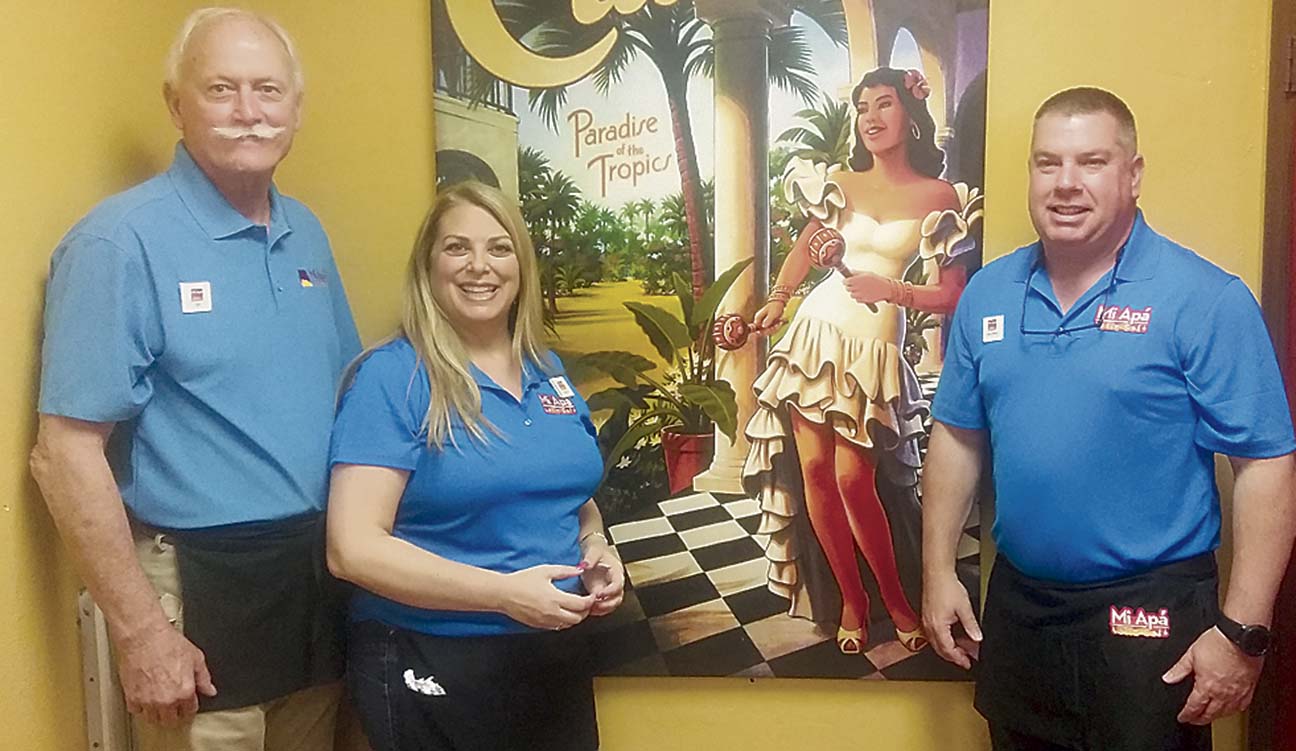ALACHUA – There was a special staff at Alachua's Mi Apa Restaurant on Feb. 19. The mayor, city commission members and city employees had a new job for the day serving food to customers at the poplar eatery.
They weren't changing careers, instead they were doing it as a fund raiser for cancer research as part of the Annual Relay for Life.
Mi Apa restaurant sponsors the “Stick a Fork In Cancer” day annually and the city employees raised $1,311 in a single day. The City of Alachua staff is one of 19 volunteer teams that help raise funds in advance of the Relay for Life event, which will be held on April 3 at the Hal Brady Recreation Complex. Combined, the 19 teams have already raised $21,098 in advance of the event with 39 fundraising days still to go.
Relay For Life is the signature fundraiser cancer walk for the American Cancer Society. Relay is staffed and coordinated by volunteers in more than 5,200 communities and 20 countries who give their time and effort taking action against cancer by funding research.
Relay For Life is a team-based fundraising cancer walk event where team members take turns walking around a track or designated path. Each event is 6-24 hours in length and each team is asked to have a member on the track at all times to signify that cancer never sleeps. Cancer patients don't stop fighting because they're tired, and the walkers want to symbolize their fight. Each team sets up a themed campsite at the event and continues their fundraising efforts by collecting donations for food, goods, games, and activities. This money will count toward their overall team fundraising goal. Many of the volunteers are cancer survivors in remission, family caregivers or those who have lost loved ones and walk in remembrance. The goal is to continue to fund research to eradicate cancer and to remember those who have lost the battle against a form of cancer.
The American Cancer Society was founded in 1913 by 10 doctors and five laypeople in New York City. It was called the American Society for the Control of Cancer (ASCC). At that time, a cancer diagnosis meant near-certain death. Rarely mentioned in public, this disease was steeped in fear and denial. Doctors sometimes did not tell their patients they had cancer, and patients often did not tell their friends and families that they had been diagnosed with it. The Society’s founders knew they had to raise public awareness about cancer if progress was to be made against this disease. The society started by writing articles for popular magazines and professional journals; publishing a monthly bulletin of cancer information and recruiting doctors throughout the country to help educate the public.
In 1945, the ASCC was reorganized as the American Cancer Society. Philanthropist Mary Lasker and her colleagues helped to raise more than $4 million for the Society in 1946 – $1 million of which was used to establish and fund the Society’s groundbreaking research program. They also helped establish the link between cancer and smoking; demonstrated the effectiveness of the Pap test; developed cancer-fighting drugs; dramatically increased the cure rate for childhood leukemia and promoted the use of mammography to identify breast cancer. Since 1946, the American Cancer Society has invested more than $4.9 billion in research. The Society was instrumental in the development of the Surgeon General’s report on the link between smoking and cancer and pushed for the passage of the National Cancer Act in 1971.
The Relay for Life event began in 1985 when Dr. Gordy Klatt, wanted to raise awareness of cancer and boost the income of his local cancer charity. He spent 24 hours circulating a track in Tacoma, Washington, and raised over $27,000. This event showed that one person really can make a difference. Since then, Relay For Life has become the largest fundraising event for cancer in the world. Celebrated by more than 4 million people in over 20 countries, this overnight event empowers and unites local communities to fight cancer.
In Alachua there is a series of events and fundraisers leading up to the actual walk. Besides each team separately finding ways to raise money and awareness, there is a Survivor Dinner on April 1 to honor the survivors who have battled cancer and their caregivers. Then, on the evening of April 3, volunteer teams and other community members will gather at the Hal Brady Recreation Complex. Each team, along with other organizations, including student groups from Santa Fe High School, will have a tent or area set up to help continue to raise money. Some will sell food or craft items, others will hold raffles or sponsor activities such as petting zoos or bike races. Each year there is also a dunking booth where local personalities and leaders will give people a chance to dump them in the water tank, with a donation for each try.
But the main focus is the walkers and survivors. At the end of the event, luminaries are lit around the walking path in memory of those who lost their battle. The goal of the Society and the Relay is to try and make sure that these lives were not lost in vain and that one day cancer will be eradicated.
# # #
Email rcarson@
alachuatoday.com
Volunteering to Beat Cancer: Alachua Officials and Staff Serve up Dinner
Tools
Typography
- Font Size
- Default
- Reading Mode


